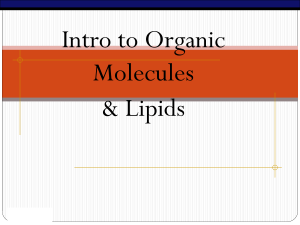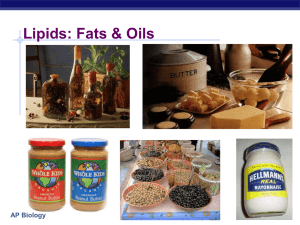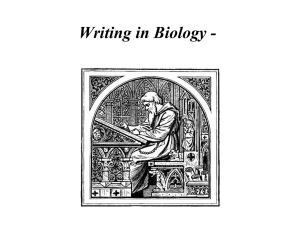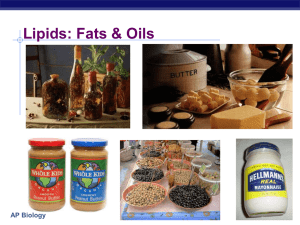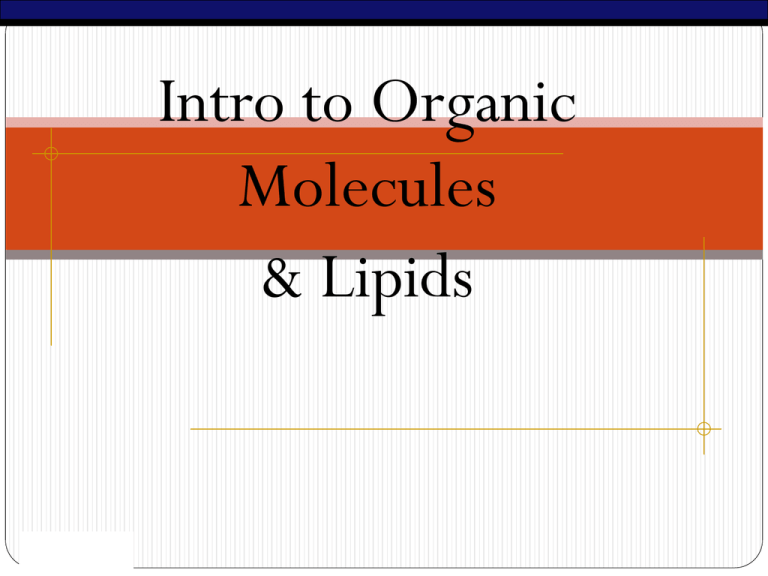
Intro to Organic
Molecules
& Lipids
AP Biology
Life is based on Carbon
Carbon atoms are versatile
building blocks
Special bonding properties
Has 4 valence electrons so it can form
4 stable covalent bonds with other carbon atoms or atoms of other
elements
Bonds with
CHNOPS – the elements that make up living things;
Carbon, Hydrogen, Nitrogen, Oxygen, Phosphorus, and Sulfur
H
H
C
H
AP Biology
H
Lipids
Lipids are organic molecules essential for life that are
composed mostly of C, H, O
4 types of lipids
fats (triglycerides)
phospholipids
steroids
waxes
AP Biology
Triglycerides
Fat molecules
Structure = 3 fatty acids chains linked to glycerol
Functions = long term energy storage and insulation for animals
Can be saturated or unsaturated
Glycerol
AP Biology
3 fatty
acids
Saturated fats
All C bonded to H
No C=C double bonds
long, straight chain
most animal fats and butter
solid at room temperature
contributes to
cardiovascular disease
AP Biology
Unsaturated fats
At least one C=C double bond in
the fatty acids
plant & fish fats
vegetable oils
liquid at room temperature
AP Biology
Saturated vs. unsaturated
saturated
AP Biology
unsaturated
Phospholipids
Structure: 2 fatty acids chains + phosphate head
Fatty acid chains = non-polar = hydrophobic “water fearing”
Phosphate head = polar = hydrophillic “water loving”
Function: make up cell membranes
(phospholipid bilayer)
AP Biology
Steroids
Structure: 4 fused Carbon rings
examples:
cholesterol – Function =control the fluidity of the cell membrane
hormones – Function = regulate processes in the body (such as pregnancy)
vitamins (A, B, D) – Function = supports metabolism and cell processes
AP Biology
Waxes
Solid at room temp
Insoluble in water
Function:
Protective covering for
animals and plants
Examples:
AP Biology
Beeswax
Earwax
Cuticle of leaf (keeps water in)
Which of the following is an example
of a type of triglyceride?
1.
2.
3.
4.
A fat containing 3 saturated
fatty acids
A fat containing 2 saturated
fatty acids & 1 unsaturated
fatty acid
A fat containing 3 unsaturated
fatty acids
All of the above
eufic.org
AP Biology
aafp.org
mpkb.org
0%
1.
0%
2.
0%
3.
0%
4.
2 Which of the following types of fats (triglycerides) would
be an oil at room temperature and would be healthier to
eat since its bent carbon & hydrogen chains and don’t
stack well?
1.
2.
3.
4.
5.
Unsaturated fat WITHOUT any C to C
double bonds
Saturated fat WITHOUT any C to C
double bonds
Unsaturated fat containing C=C
Saturated fat containing C=C
Steroids like testosterone hormone or
cholesterol
eufic.org
AP Biology
aafp.org
mpkb.org
0%
1.
0%
2.
0%
3.
0%
4.
3 Which type of lipid makes up the
majority of the cell membrane?
1. phospholipids
2. waxes
3. steroids
4. triglycerides
AP Biology
essortment.com
alevelnotes.com
0%
1.
0%
2.
0%
3.
0%
4.
4 Phospholipids contain:
1.
2.
A hydrophobic polar phosphate head & 2
hydrophilic nonpolar fatty acid tails
A hydrophilic polar phosphate head & 2
hydrophobic nonpolar fatty acid tails
AP Biology
http://myhome.sunyocc.edu/~weiskirl/Alcamo_membra
ne.gif
5 Which is an example of a steroid?
Structure of triglycerides: fats
1. Fatty acids
& oils
2. Sex hormones
3. Phospholipids
4. Olive Oil
5. Triglycerides
0%
0%
0%
2.
3.
0%
0%
4.
5.
AP Biology
1.
Structure of
sex
hormones
6 What is the function of a
triglyceride?
1. Stores and transfers
genetic information
2. Long term energy storage,
as well as insulation &
protection
3. Control the rate of
reactions
4. Help to fight disease
AP Biology
0%
1.
0%
2.
0%
3.
0%
4.
7 What is the function of hormones such as the steroid
hormones?
1. Communication &
cooperation between cells
2. Short term energy storage
3. Structural building
materials
4. Compose the bilayer cell
membrane
0%
AP Biology
1.
0%
2.
0%
3.
0%
4.
8 What is the cholesterol
considered a steroid?
1. They have a similar
hydrophobic structure
2. The both contain rings
made mostly of Carbon
and Hydrogen atoms
3. They are both nonpolar
covalent
4. All of the above
AP Biology
cholesterol
0%
1.
0%
2.
0%
3.
0%
4.

